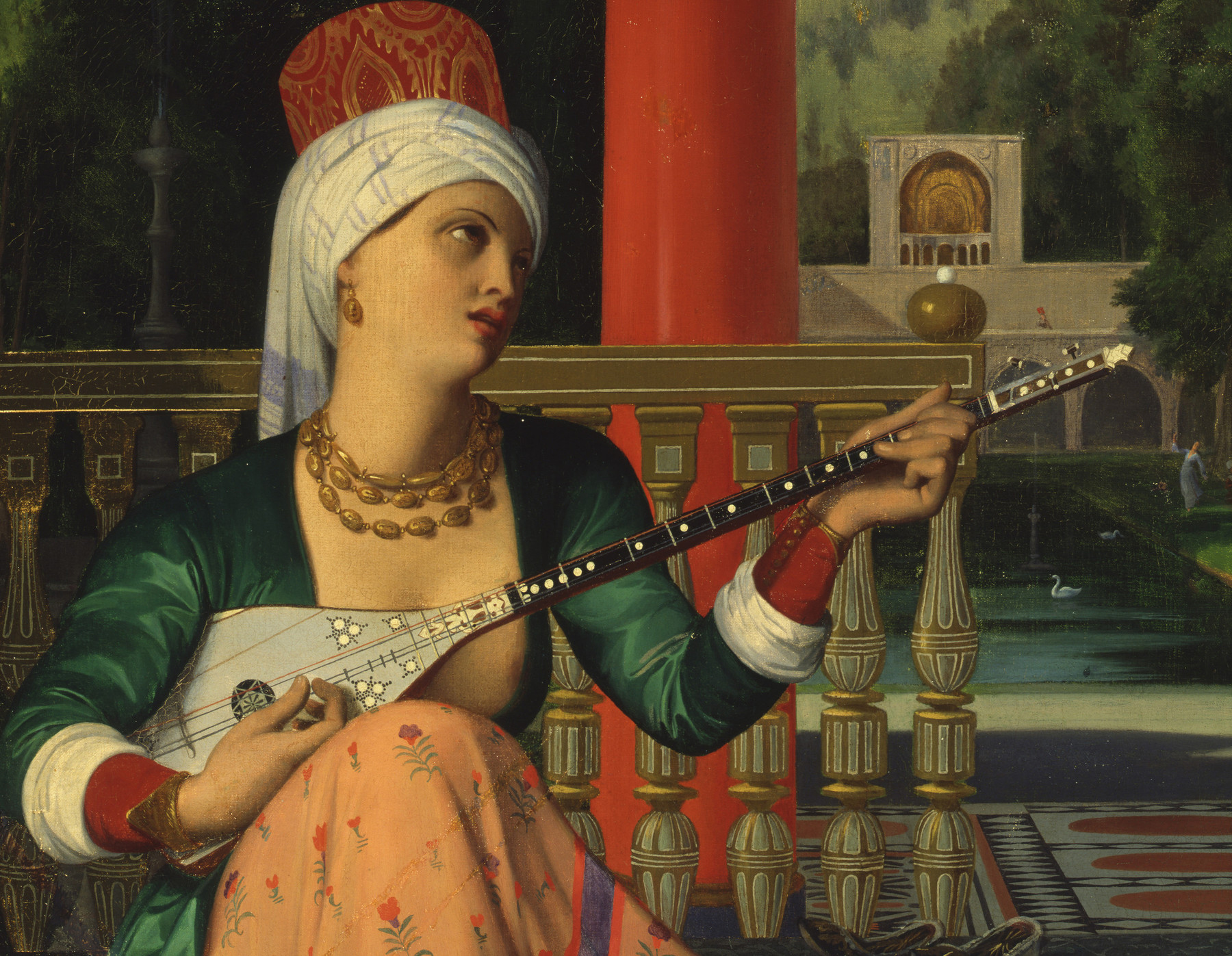Odalisque
(18th and 19th Centuries )
This highly eroticized harem scene is a fantasy on the part of the artist, reflecting long-standing prejudiced beliefs about beauty. The artist makes a blond and white-skinned woman the focus of the painting. It may be that she is intended to represent a Circassian, an ethnic group indigenous to the Caucasian region (between the Black and Caspian Seas on the edge of eastern Europe and western Asia). Since the 1500s, Circassian women had been singled out in European and Islamic painting and literature as the most beautiful of all.
Although it depicts an imagined scene, the painting reinforces interrelated hierarchies of gender, race, and labor. The reclining white woman is attended by two companions: a woman with a darker skin tone who entertains her, while a man with black skin stands guard in the background. For the assumed European viewer, these visual cues set the white woman apart as an object of beauty, and although captive, deserving of the care and attention of the figures surrounding her. Ingres’s painting also reinforces European stereotypes of the “East” as a region where sexuality, slavery, opulent wealth, and exquisite beauty were equated with the fabled power of the region’s rulers. These stereotypes persist, as well as prejudiced views about beauty.
This painting was commissioned by King Wilhelm I of Württemberg and was executed by Ingres with the assistance of his pupil Paul Flandrin. A version of this subject painted three years earlier sets the scene in an enclosed room rather than with a garden vista in the background (Fogg Art Museum, Cambridge, Massachusetts). The composition was inspired by a passage from Lady Mary Wortley Montagu's Turkish Letters (1763), and may have been conceived by Ingres in response to his rival Eugène Delacroix's success as a painter of Near Eastern subjects
.
Inscription
Provenance
Provenance (from the French provenir, 'to come from/forth') is the chronology of the ownership, custody, or location of a historical object. Learn more about provenance at the Walters.
Wilhelm I, King of Wurtemberg, 1842, by commission; Delessert [date and mode of acquisition unknown]; Baron Gustave de Rothschild, [date and mode of acquisition unknown]; Sir Phillip Sassoon, London [date and mode of acquisition unknown]; Wildenstein and Co., New York [date and mode of acquisition unknown]; Henry Walters, Baltimore, 1925, by purchase [with encouragement of Bryson Burroughs, Wildenstein & Co.]; Walters Art Museum, 1931, by bequest.
Exhibitions
| 2014-2016 | From Rye to Raphael: The Walters Story. The Walters Art Museum, Baltimore. |
| 2000-2002 | Triumph of French Painting: Masterpieces from Ingres to Matisse. Baltimore Museum of Art, Baltimore; Philbrook Museum of Art, Tulsa; Norton Museum of Art, West Palm Beach; Dayton Art Institute, Dayton; Royal Academy of Arts, London; Albright-Knox Art Gallery, Buffalo. |
| 1961 | Ingres in American Collections. Paul Rosenberg & Co., New York, New York. |
| 1954 | Inaugural Exhibition at the Fort Worth Art Center. Fort Worth Art Center, Fort Worth. |
| 1951 | From Ingres to Gauguin: French Nineteenth Century Paintings Owned in Maryland. Baltimore Museum of Art, Baltimore. |
| 2026 | French Master Paintings from Baltimore. Baltimore Museum of Art, Baltimore; The Walters Art Museum, Baltimore. 2001-0. |
Conservation
| Date | Description | Narrative |
|---|---|---|
| 2/2/1948 | Treatment | cleaned; loss compensation; other |
| 3/7/1955 | Examination | examined for condition |
| 5/1/1963 | Examination | examined for condition |
| 5/31/1983 | Examination | examined for condition |
| 6/14/1983 | Treatment | cleaned; coated; repaired; loss compensation; other |
| 11/12/1984 | Examination | examined for exhibition |
| 8/16/1990 | Treatment | repaired |
| 8/1/1991 | Treatment | cleaned; loss compensation; coated; other |
| 7/31/1992 | Treatment | loss compensation; other |
| 4/8/1999 | Examination | examined for condition |
Measurements
H: 29 15/16 x W: 41 5/16 in. (76 x 105 cm)
Credit Line
Acquired by Henry Walters, 1925
Location in Museum
Not on view
Accession Number
In libraries, galleries, museums, and archives, an accession number is a unique identifier assigned to each object in the collection.
In libraries, galleries, museums, and archives, an accession number is a unique identifier assigned to each object in the collection.
37.887






